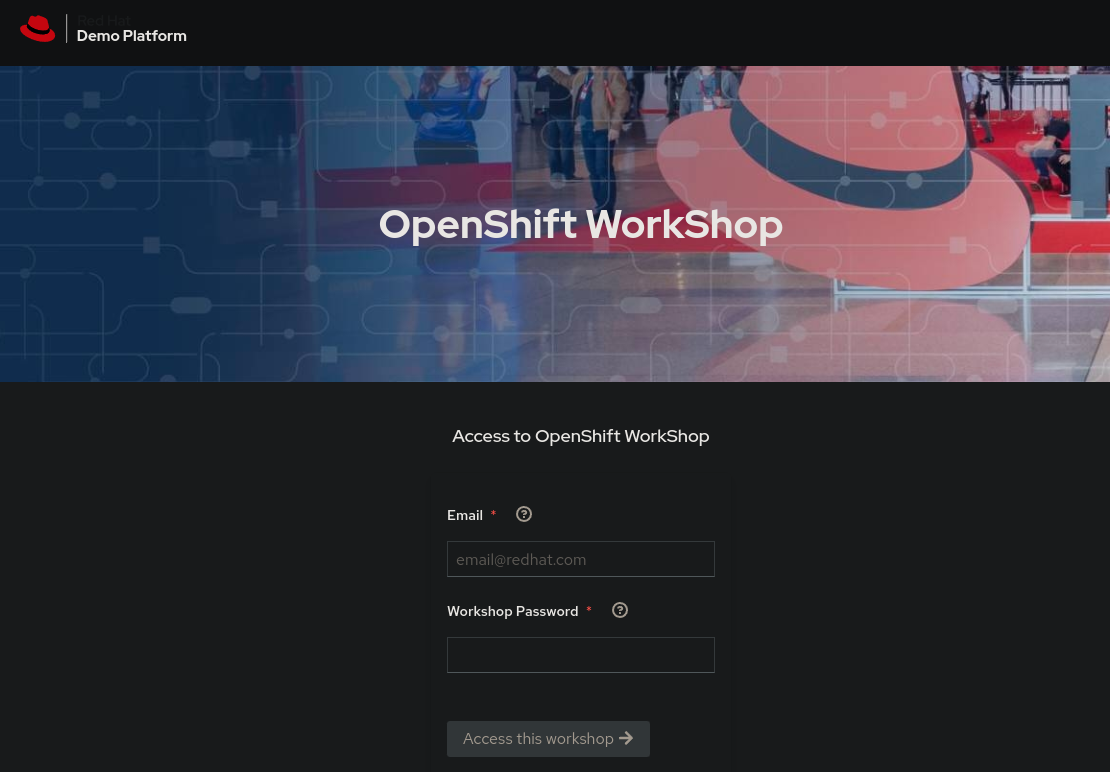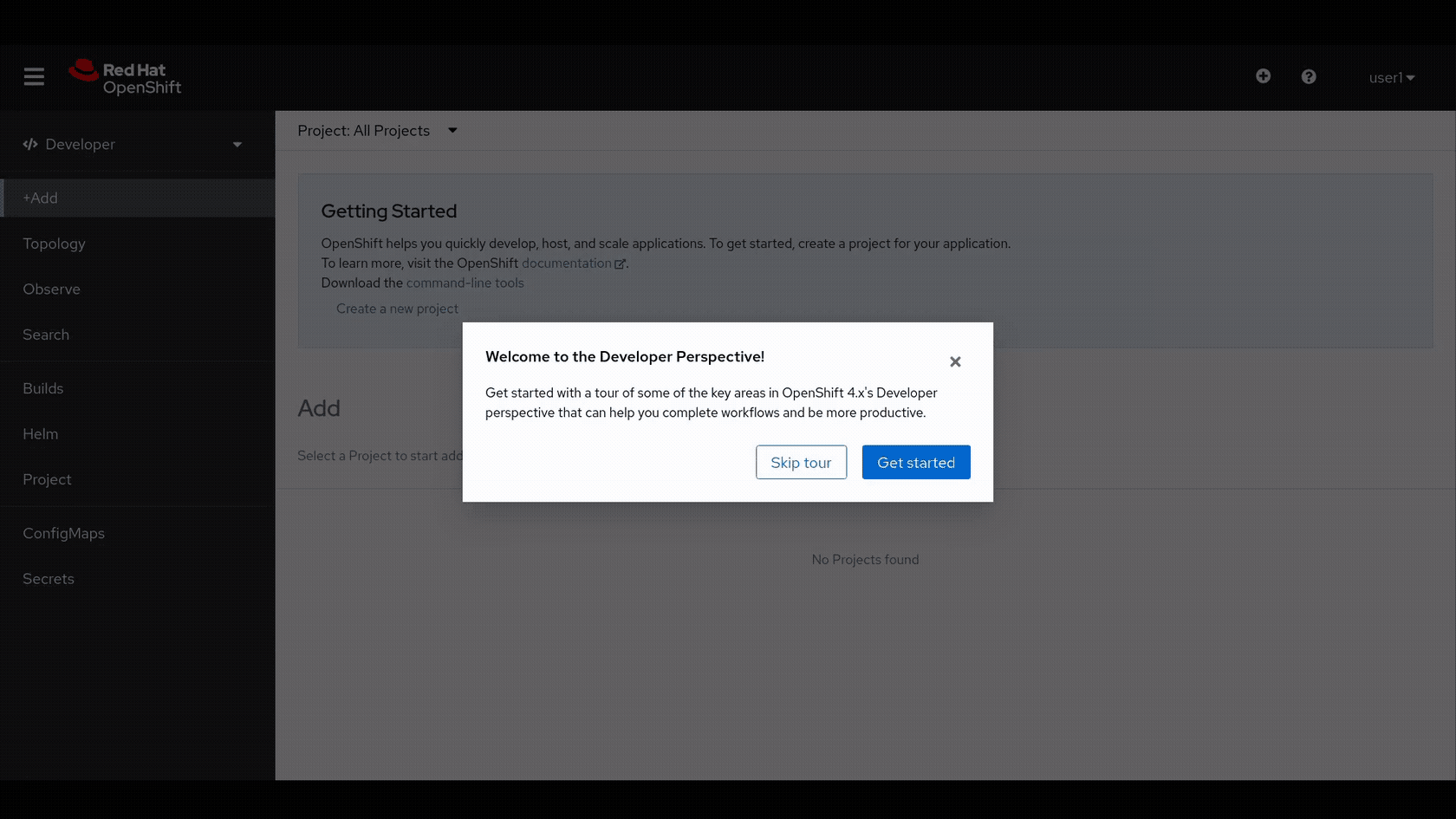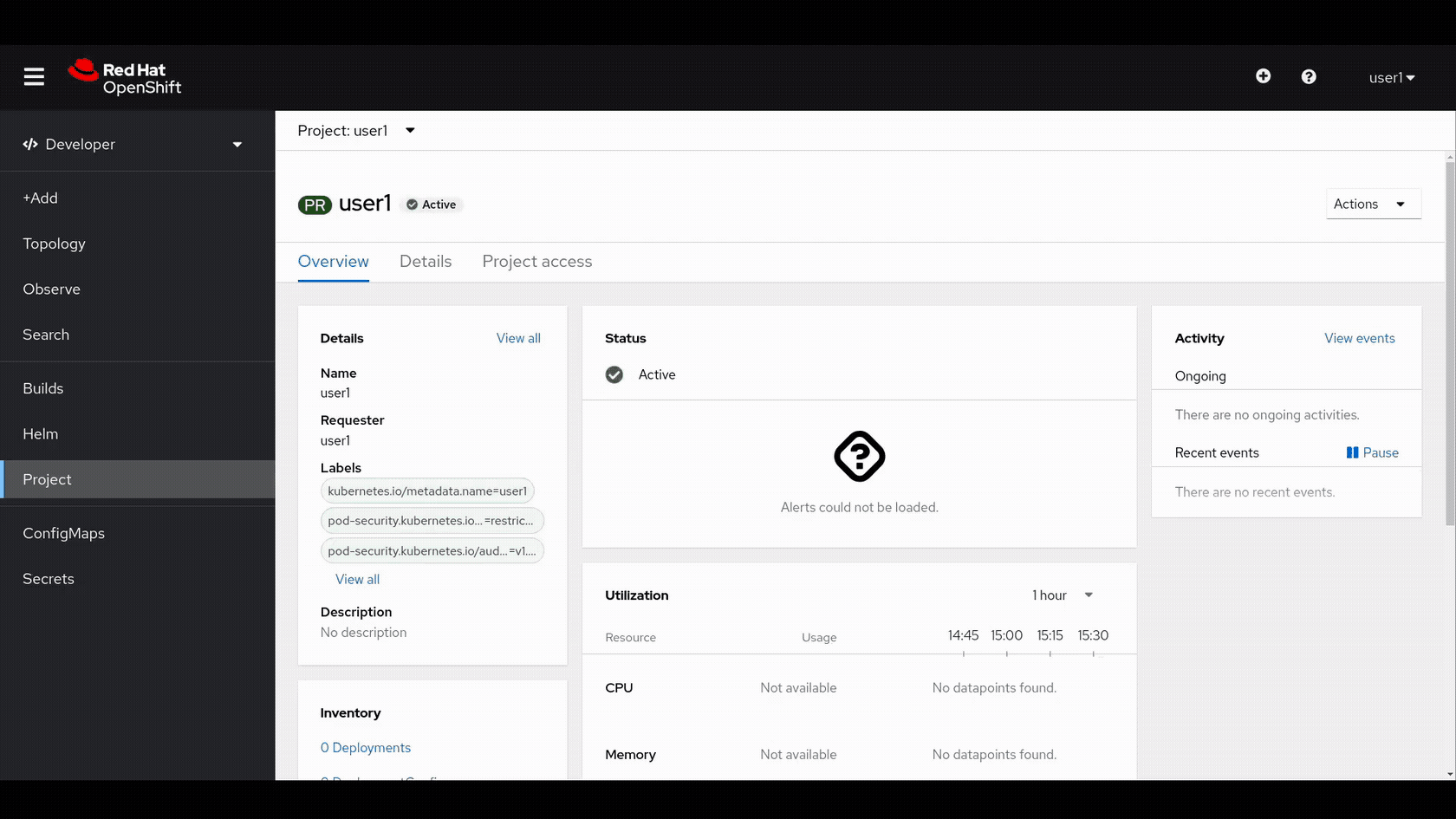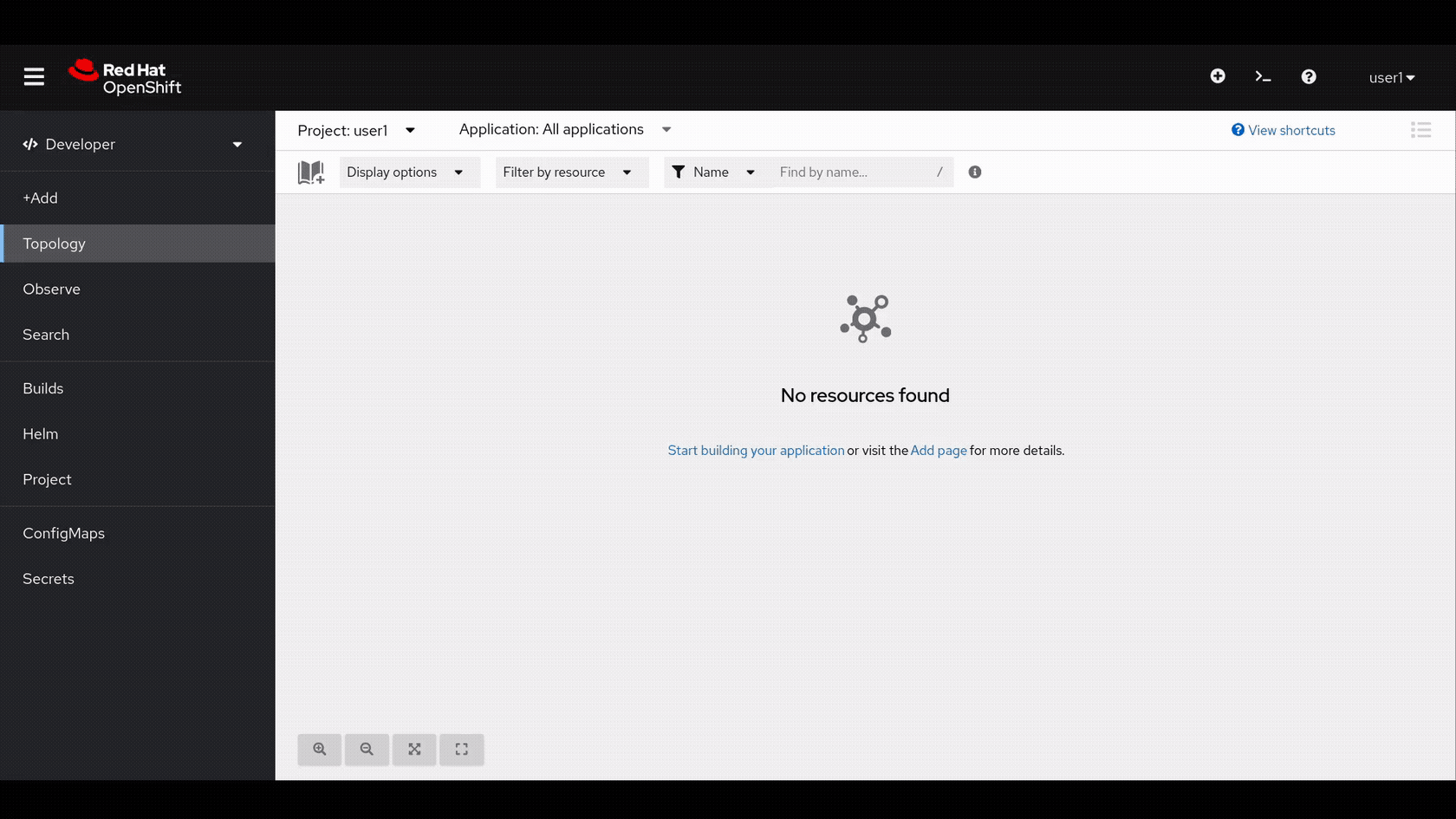- Published on
- Exercise 1
Getting familiar with OpenShift
- Authors
- Name
Red Hat OpenShift is a unified platform to build, modernize, and deploy applications at scale. In this first excercise we'll get logged into our cluster and familarise ourselves with the OpenShift web console and web terminal.
The OpenShift Container Platform web console is a feature-rich user interface with both an Administrator perspective and a Developer perspective accessible through any modern web browser. You can use the web console to visualize, browse, and manage your OpenShift cluster and the applications running on it.
In addition to the web console, OpenShift includes command line tools to provide users with a nice interface to work with applications deployed to the platform. The oc command line tool is available for Linux, macOS or Windows.
Let's get started!
1.1 - Login to lab environment
An OpenShift 4.16 cluster has already been provisioned for you to complete these excercises. Open your web browser and navigate to the workshop login page https://demo.redhat.com/workshop/qrz23h.
Once the page loads you can login with the details provided by your workshop facilitator.
| |
|:-----------------------------------------------------------------------------:|
| Workshop login page |
|
|:-----------------------------------------------------------------------------:|
| Workshop login page |
1.2 - Login to the cluster web console
Once you're logged into the lab environnment we can open up the OpenShift web console and login with the credentials provided.
When first logging in you will be prompted to take a tour of the Developer console view, let's do that now.
|  |
|:-----------------------------------------------------------------------------:|
| Developer perspective web console tour |
|
|:-----------------------------------------------------------------------------:|
| Developer perspective web console tour |
1.3 - Understanding projects
Projects are a logical boundary to help you organize your applications. An OpenShift project allows a community of users (or a single user) to organize and manage their work in isolation from other projects.
Each project has its own resources, role based access control (who can or cannot perform actions), and constraints (quotas and limits on resources, etc).
Projects act as a "wrapper" around all the application services you (or your teams) are using for your work.
In this lab environment, you already have access to single project: userX (Where X is the number of your user allocted for the workshop from the previous step.)
Let's click into our Project from the left hand panel of the Developer web console perspective. We should be able to see that our project has no Deployments and there are no compute cpu or memory resources currently being consumed.
| |
|:-----------------------------------------------------------------------------:|
| Developer perspective project view |
|
|:-----------------------------------------------------------------------------:|
| Developer perspective project view |
1.4 - Switching between perspectives
Different roles have different needs when it comes to viewing details within the OpenShift web console. At the top of the left navigation menu, you can toggle between the Administrator perspective and the Developer perspective.
Select Administrator to switch to the Administrator perspective.
Once the Administrator perspective loads, you should be in the "Home" view and see a wider array of menu sections in the left hand navigation panel.
Switch back to the Developer perspective. Once the Developer perspective loads, select the Topology view.
Right now, there are no applications or components to view in your userX project, but once you begin working on the lab, you’ll be able to visualize and interact with the components in your application here.
| |
|:-----------------------------------------------------------------------------:|
| Switching web console perspectives |
|
|:-----------------------------------------------------------------------------:|
| Switching web console perspectives |
1.5 - Launching a web terminal
While web interfaces are comfortable and easy to use, sometimes we want to quickly run more advanced commands to get things done. That is where the oc command line utility comes in.
One handy feature of the OpenShift web console is we can launch a web terminal that will create a browser based terminal that already has the oc command logged in and ready to use.
Let's launch a web terminal now by clicking the terminal button in the top right hand corner and then clicking Start with our userX project selected.
| |
|:-----------------------------------------------------------------------------:|
| Launching your web terminal |
|
|:-----------------------------------------------------------------------------:|
| Launching your web terminal |
1.6 - Running oc commands
The oc command line utility is a superset of the upstream kubernetes kubectl command line utility. This means it can do everything that kubectl can do, plus some additional OpenShift specific commands.
Let's try a few commands now:
Checking our current project
Most actions we take in OpenShift will be in relation to a particular project. We can check which project we are currently actively using by running the oc project command.
We should see output similar to below showing we are currently using our userX project:
bash-4.4 ~ $ oc project
Using project "user1" from context named "user1-context" on server "https://172.31.0.1:443".
Getting help and explaining concepts
As with any command line utility, there can be complexity that quickly surfaces. Thankfully the oc command line utility has excellent built in help.
Let's take a look at that now.
To get an understanding of all the options available, try running oc help. You should see options similar to the below sample:
bash-4.4 ~ $ oc help
OpenShift Client
This client helps you develop, build, deploy, and run your applications on any
OpenShift or Kubernetes cluster. It also includes the administrative
commands for managing a cluster under the 'adm' subcommand.
Basic Commands:
login Log in to a server
new-project Request a new project
new-app Create a new application
status Show an overview of the current project
project Switch to another project
projects Display existing projects
explain Get documentation for a resource
Build and Deploy Commands:
rollout Manage a Kubernetes deployment or OpenShift deployment config
rollback Revert part of an application back to a previous deployment
new-build Create a new build configuration
start-build Start a new build
cancel-build Cancel running, pending, or new builds
import-image Import images from a container image registry
tag Tag existing images into image streams
To get a more detailed explanataion about a specific concept we can use the oc explain command.
Let's run oc explain project now to learn more about the concept of a project we introduced earlier:
bash-4.4 ~ $ oc explain project
KIND: Project
VERSION: project.openshift.io/v1
DESCRIPTION:
Projects are the unit of isolation and collaboration in OpenShift. A
project has one or more members, a quota on the resources that the project
may consume, and the security controls on the resources in the project.
Within a project, members may have different roles - project administrators
can set membership, editors can create and manage the resources, and
viewers can see but not access running containers. In a normal cluster
project administrators are not able to alter their quotas - that is
restricted to cluster administrators.
Listing or watching projects will return only projects the user has the
reader role on.
An OpenShift project is an alternative representation of a Kubernetes
namespace. Projects are exposed as editable to end users while namespaces
are not. Direct creation of a project is typically restricted to
administrators, while end users should use the requestproject resource.
That's a quick introduction to the oc command line utility. Let's close our web terminal now so we can move on to the next excercise.
| |
|:-----------------------------------------------------------------------------:|
| Closing your web terminal |
|
|:-----------------------------------------------------------------------------:|
| Closing your web terminal |
Well done, you're now ready to move on to Exercise 2 and deploy an application! 🎉